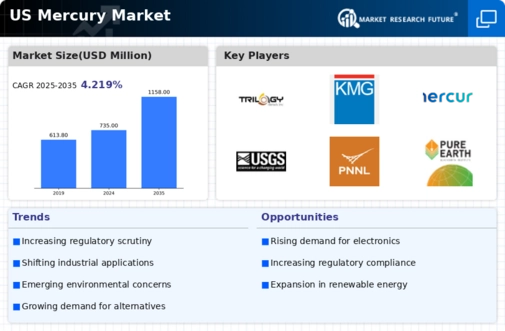The competitive insights of the US Mercury Market highlight the dynamic landscape shaped by various factors, including regulatory frameworks, environmental concerns, market demand, and technological advancements. As an essential chemical element used in numerous industrial applications, mercury has witnessed shifting perceptions due to its toxicity and environmental impact.
This has led to companies in the market seeking sustainable practices and innovative solutions to address these challenges. Stakeholders across the sector are actively monitoring market trends, competitor actions, and potential disruptions while seeking opportunities for growth and collaboration. The strategic maneuvers of industry players are critical as they navigate the complexities of compliance and consumer awareness while striving for efficiency and profitability.
FMC Corporation has established a significant presence in the US Mercury Market, showcasing its strength through a diverse range of products that cater to various industrial applications. The company has leveraged its advanced technological capabilities to develop mercury-based solutions that meet strict regulatory standards while addressing environmental concerns.
With a focus on innovation, FMC Corporation emphasizes the importance of research and development to enhance the efficacy and safety of its offerings. This commitment to excellence allows FMC to maintain a competitive edge, and its strong customer relationships have further bolstered its position in the market.
The company contributes not only through its product portfolio but also by engaging in proactive dialogue about responsible mercury use, which resonates with stakeholders who prioritize sustainability.
Trilogy Metals has also made substantial contributions to the US Mercury Market, focusing on strategic initiatives that align with industry trends and regulatory demands. Known for its high-quality mining jurisdiction within the US, the company emphasizes responsible resource extraction and environmental stewardship.
Its key products include various mercury compounds and by-products associated with mining operations, which cater to specialized applications. Trilogy Metals balances its operations with a commitment to sustainability and community engagement, further strengthening its market presence.
The company's strengths lie in its robust exploration strategies and potential mergers and acquisitions aimed at expanding its portfolio and enhancing operational efficiencies. By prioritizing environmentally friendly practices and innovative processing technologies, Trilogy Metals positions itself as a forward-thinking player in the US Mercury Market, contributing to an evolving industry landscape.


















Leave a Comment